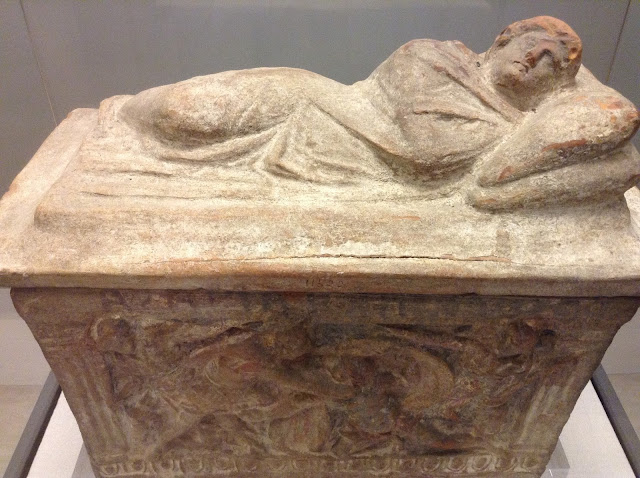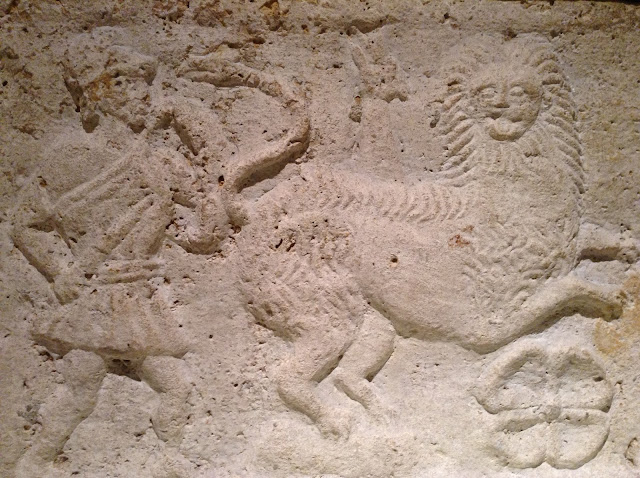"Don't plant any tree before planting the vine." - Alcaeus of Mytilene (6th century BCE)
Attic ceramic Dionysian scene, (400-350 BCE) National Archeological Museum, Madrid.
Attic ceramic Trojan War scene, (460-450 BCE) Catalan Archeological Museum, Empuries.
Attic ceramic Mythological scene, (400-325 BCE) Catalan Archeological Museum, Barcelona.
Attic ceramic Symposium scene, (400-350 BCE) National Archeological Museum, Madrid.
Attic ceramic Dionysian scene, (400-430 BCE) National Archeological Museum, Madrid.
Attic ceramic image of Dionysus, (550-500 BCE) Catalan Archeological Museum, Girona.
"The Mediterranean peoples began to emerge from barbarism when they learnt how to cultivate the vine and olive trees." - Thucydides (5th century BCE)
South Italian red-figure pottery, (6th-4th century BCE)
Marble Naiskos, (4th-3rd century BCE) Cybele, Goddess of Fertility.
The cult of the goddess Cybele was popular in the ancient world. It began in the sixth century BCE in Asis Minor, crossed to Athens and then Rome. Cybele embodied the earth's fertility. In this image she appears enthroned with her characteristic attributes, the tympanum (a kind of tambourine) and phials (a bowl for making libations).
Large jug painted with geometric motifs, (8th-7th century BCE)
Etruscan terracotta, (4th-3rd century BCE)
Houses of the soul. In the ancient world, funerary urns often imitated architectural forms. Just like this Etruscan urn, which looks like a small house with a gable roof. Inside lived the soul of the deceased person. There are traces of blue paint on the cover, but at one time it must have been painted all over in eye-catching but tasteful colours.
Etruscan calcareous stone urn and lid. (3rd-2nd century BCE) Warrior & Chimaera. You can see a warrior with his sword unsheathed chasing a chimaera, a mythical animal with a lion's head. From his body sports a second head, the head of a goat. The tail ends with a third head, that of a snake, which threatens the warrior with its open mouth and forked tongue. The struggle between warrior and chimaera represents the strength and courage of the deceased person.
Art from the colonies. Around the 8th century BCE the Greeks colonised southern Italy and part of the island of Sicily. The Greek colonies, which were never a political unit, adopted Hellenic language, traditions, religion and art forms which they mixed with their own. The shape of these vessels follows Greek models but the drawings on them have a style all their own, quite different from pieces made in Greece.
Utensils for lighting and making offerings, military insignia, figures of gods and animals and ornaments for furniture, bronze pieces from the Roman Era which have survived to the present. Produced by hammering mould casting or lost wax technique. In the lost wax method, a mould was made from bee's wax and covered in clay. It was then placed in a kiln and fired so the wax melted and ran out through some holes. Once cold and rested, the clay could be filled with molten bronze. This procedure allows even the smallest details to be reproduced.
The best known terracotta figurines were made in Tanager near Athens, creating a fashion that lasted for centuries. Cast in moulds, they represented everyday figures or mythological scenes. They were extremely popular with collectors and had a great influence on Neo-Classical art, particularly the Empire style which copied many of their narrative and sentimental themes.
Roman Hermes marble bust, (1st-2nd century CE)
Roman tragedy actor mask, (1st century CE) Empuries.
Attic marble funeral stela, (2nd-3rd century CE) inscription: ΦΙΛΟΜΟΥΣΟΣ ΘΕΟΦΙΛΟΥ ΙΟΥ ΚΟΥΝΔΑ ΦΙΛΟΜΟΥΣΟΥ (Philomusos son of Theophilus, Konda daughter of Philomusos)
ΔΙΦΙΛΟΣ ΞΕΝΟΚΛΕΙΔΟΘΣ (Diphilos son of Xenoclides)
"Wine is more pleasing to me when that which I drink is not mine."
- Diogenes the Cinic (4th century BCE)
Attic ceramic musical scene, (425-400 BCE) Catalan Archeological Museum, Barcelona.
Attic ceramic scene of children's games, (425-400 BCE) Catalan Archeological Museum, Ullastret.
During the 2nd day of the Antesterias festival, three year old Athenian children were initiated into the ritual of wine drinking. They were offered a small ceramic jar, made for the occasion, decorated with images of childhood. It was a symbolic act of communion with divinity and their integration into the community.
Alabaster Attic ceramic image of Dionysus, Satires and Meneades, (500-475 BCE) Catalan Archeological Museum, Girona.
Greek vase (4th century BCE) The myth of Pandora.
Minerva. A remarkable bronze piece from the Roman period on Mallorca. Probably an imitation of a Greek model. The fineness of the helmet, head and dress covered with a "himation" is of particular note. (1st century BCE)
Ceramic drinking cup with mythological imagery of the struggle between Athena and the giants. (6th century BCE) Empuries.
Bronze Etruscan engraving. Mythological imagery of the judgement of Paris. With the three goddesses Aphrodite, Hera and Athena on the left. (4th-3rd century BCE) Empuries.
Greek inscriptions written on ceramic pots and vases found in Emporion. They may elude to fishing, the users name or a dedication or votive offering to a god. (5th-4th century BCE) Empuries.





















































